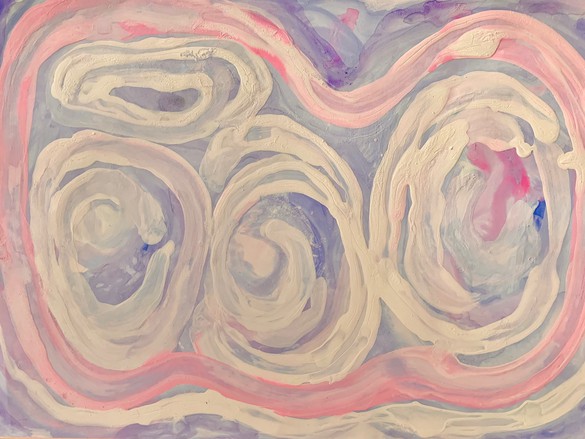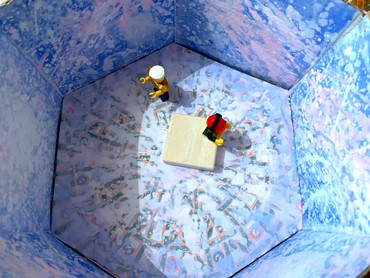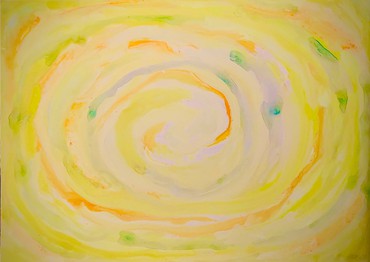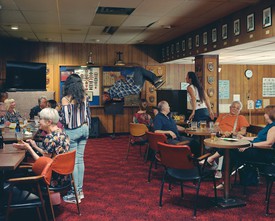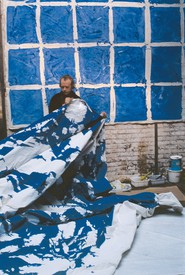Alberto Di Fabio found refuge in his artistic practice when escaping COVID-19. The artist, known internationally for his large-scale canvases and murals, shifted to small projects, building a lilliputian world, made up of miniature theaters animated with his children’s Legos and with nails and masks that serve as studies for future wall paintings. The playful, dreamlike, and fabled atmosphere engages virtual audiences with the new Mandalas. These works, which were previewed in the recent exhibition at the Luca Tommasi Gallery in Milan, appear more fluid and less tangible than the earlier works still on display in New York at GR Gallery, and in Rome at Gaggenau Designelementi.
Understanding the genesis of Di Fabio’s Mandala works allows us to appreciate their consistency with his oeuvre, which is often misunderstood by those who mistake his paintings for ethereal visual manifestations of joy, when in fact, Di Fabio’s works are the result of his insatiable desire for perfection that finds catharsis and relief precisely in creative gesture. In a recent conversation, the artist described his works as “universal prayers for the world to come,” adding that he would like to leave behind a visual book for future generations that would explain his thoughts. Taking this into consideration, the Mandalas can easily be traced back as the culmination of that search for elevation and transcendence that has driven Di Fabio since the 1990s, when he began painting mountains on Chinese paper printed with mantras.
In these new works, the artist has achieved a syncretism of various religious, spiritual, and artistic elements and references dear to him: if on one hand he recovers the ritual dimension of geometric Hindu mandalas, on the other, the strong reference to Buddhist mandalas is undeniable. These mandalas represent the universe in its complexity, a synthesis of periphery and center, with elements that are perceived as “opposite” to us. Moreover, the compulsion in representing them becomes itself a prayer, detached from reality, and a ritual not so performative as it is salving, aimed at reaching, understanding, and representing the essence of reality. After all, the very word “mandala,” according to some interpretations, can mean “to collect the essence.” It’s no wonder, then, that this step forward in Di Fabio’s artistic and personal research arrived amidst these weeks that have been so difficult for all of us—he had the time and the opportunity to reflect and meditate on how to restart and/or move forward.
Today, Di Fabio has tapped into his most authentic self, transforming the stasis of quarantine into a necessary preparatory phase for his artistic future. Those close to Di Fabio know that he is as dynamic as he is sociable—far away from his studio, with his sons and cat, he has resiliently managed to convert his garage into a studio, where he invites his friends to visit him via video chat, telephone, and other socially distant modes of communication. The history of these works and their origin recalls the well-known sunflowers of Vincent van Gogh, painted by the Dutch artist in Arles. Sunflowers are the flower of the sun—a living mandala—embodying the perfection and complexity of the universe. Like Van Gogh in 1888, Di Fabio found himself poised between wanting/having to live in solitude and the desire to communicate and socialize: in fact, many are unaware that most of Van Gogh’s sunflower paintings constituted a moment of catharsis for the artist, who painted them in a yellow house in Arles during a short period of happiness he found after so much solitude, when his beloved friend and fellow artist Paul Gauguin visited him and lived—in poverty—with him. Similarly, Di Fabio’s mandalas represent a rediscovered happiness, a sign that art can transform physical constraints and loneliness—today caused by the COVID-19 pandemic—into a sublimation of the soul, with the occasion to free one’s own art. The true essence of Di Fabio’s mandalas is perhaps this: despite everything, art cannot, and must not, be confined.
This text originally appeared in Italian on Artribune’s website. Translated from the Italian by Louis Vaccara
